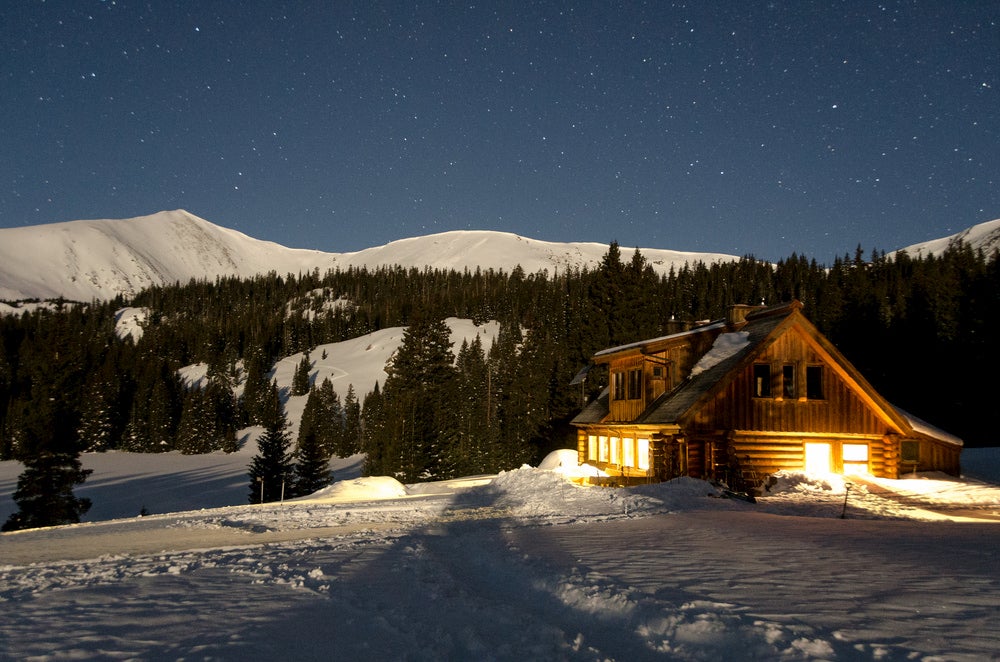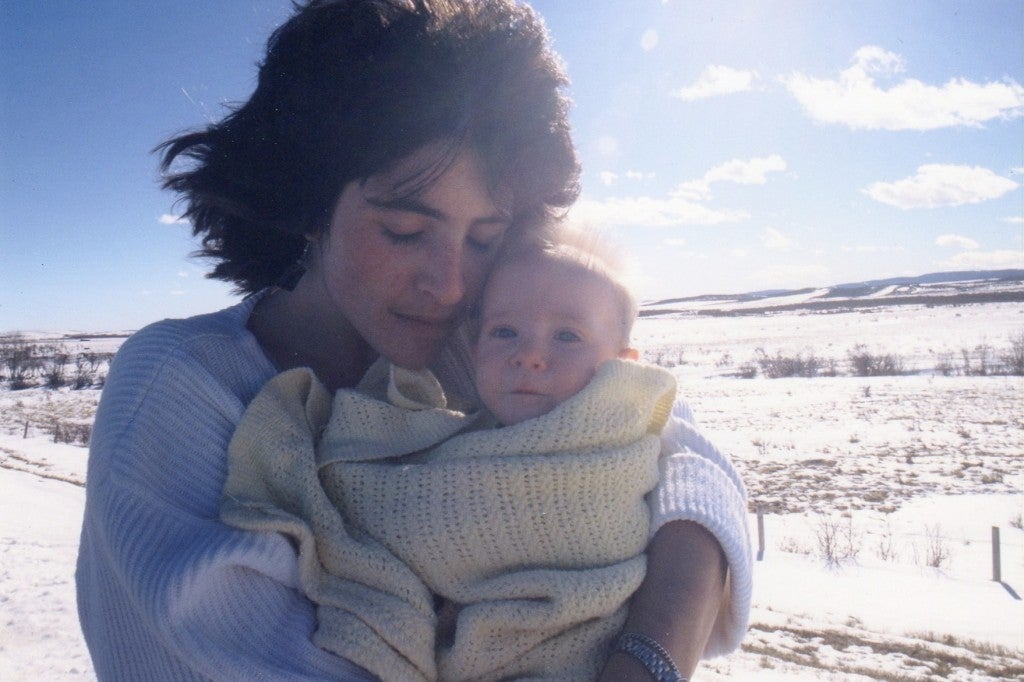This guide to Colorado’s 10th Mountain Division Huts is brought to you by OOFOS. OOFOS’ recovery apparel is made from a patented, closed-cell foam that provides 37% more impact absorption than traditional athletic shoes, all while maintaining an incredibly lightweight frame.
Colorado’s history is rich with stories of soldiers and pioneers, from Zebulon Pike, famous for being the first to spot (and name) Pikes Peak to Mary Cronin, one of the key developers of the Colorado Mountain Club (CMC),and the first woman to summit each of state’s 58 peaks sitting at over 14,000 feet in elevation (otherwise known as 14ers). In addition to the famous faces that dot Colorado’s history, the string of backcountry cabins known as the 10th Mountain Division Huts serve as modern-day emblems of the extensive mountain military history in the wilderness just outside of Leadville, Colorado.
The Ultimate Guide to Colorado’s 10th Mountain Division Huts
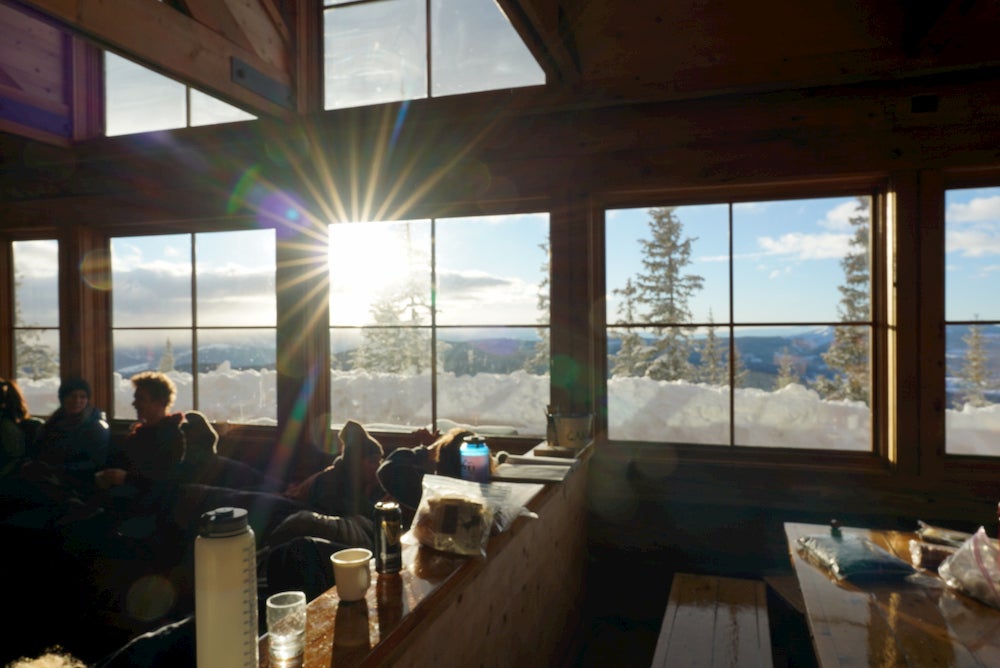
Image from The Dyrt camper Jesse Nestler
Years before the construction of the 10th Mountain Division Huts, the mountains of Leadville, Colorado were filled with U.S. Army soldiers training for combat. Located over 10,000 feet above sea level, the country’s highest established city was the perfect place to train soldiers whose duty it was to navigate the snowy peaks of Europe during WWII. Soldiers were trained to ski, shoot, navigate, and climb their way through the ice, rocky terrain, and bitter cold. Their unit’s name? The 10th Mountain Division.
Once their training was completed, the members of the 10th Mountain Division were sent to Europe, where, in the mountains of Italy, they served for the duration of WWII and navigated their way through Europe’s classic hut system, which provided shelter and warmth on the grueling winter journey through the Alps.
Upon returning from WWII, dozens of members of the 10th Mountain Division made the choice to return to their training grounds in the mountains of Colorado. By 1980, veterans of the 10th Mountain Division were craving a way to remember their time overseas, and a way to continue to connect with outdoor enthusiasts trekking through the alpine wilderness. One of these 10th Mountain Division vets, Fritz Benedict, dreamt of replicating the European hut system right outside of Leadville, so he created a project called the 10th Mountain Division Hut Association— through which supporters (including former U.S. Secretary of Defense Robert McNamara) could help fund the construction of small mountain huts throughout the Colorado wilderness. The first two of these huts were built in 1982, and named after those who funded them, namely Secretary McNamara and his wife, Margaret.
For the next three decades, the 10th Mountain Division Association promoted and oversaw the construction of over 30 huts accessible to hikers throughout the mountains surrounding Leadville. Today, 15 of the 33 10th Mountain Division Huts are still owned, maintained, and operated by the Association, while 18 have been handed over to private owners or nonprofits, under the requirement that they remain open and accessible to the public. Many of the huts’ names correspond to members of the 10th Mountain Division who were killed in action, serving as physical markers of remembrance for those who served throughout the years as part of the 10th Mountain Division.
The 10th Mountain Division Huts Today
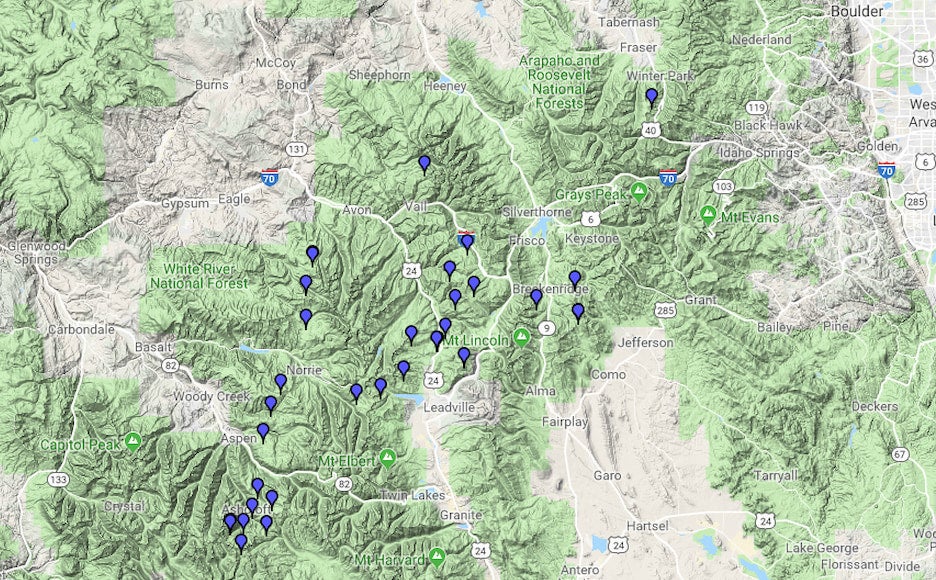
Today, the 10th Mountain Division Huts make up one of the largest networks of mountain huts in the country, and sharing the history of the huts is almost as important as maintaining the huts themselves. Each hut contains its own history book detailing the unique story of its construction, and the various supporters along the way.
The sizes of the huts vary, accommodating between 4 and 26 people, though all huts offer cooking and eating utensils, a wood stove, and burners run on propane gas.
Unlike most hut networks throughout the United States, several of the 10th Mountain Division Huts are open year-round, offering visitors the chance to hike from hut to hut instead of relying solely on cross-country skiing or snowshoeing. The following list previews the capacity (in parentheses next to the cabin name), booking minimums, and seasonal schedules of all of the 10th Mountain Division Huts.
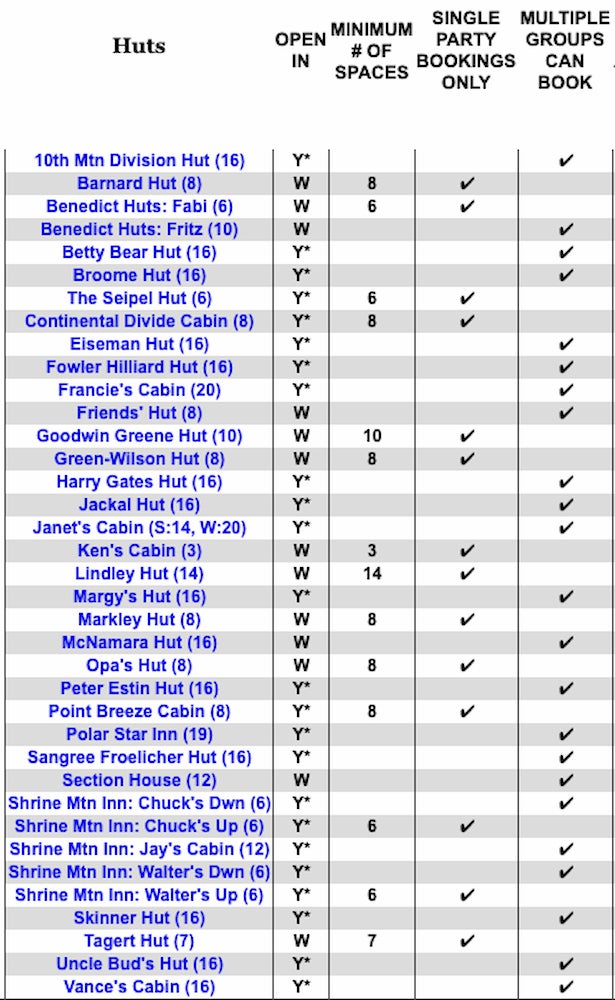
*Y – year-round
W – winter only
Notable also among the huts is that only 5 of the 33 huts listed (the 5 Shrine Mtn Inn huts) offer flushing toilets. The rest either offer indoor composting toilets (Broome Hut, Francie’s Cabin, and Janet’s Cabin) or outhouses located outside of the main cabin area. Only four of the huts (Continental Divide Cabin, Point Breeze Cabin, Shrine Mtn. Inn: Chuck’s Up, and Shrine Mtn. Inn: Walter’s Up) offer refrigeration, and all huts require visitors to bring and cook their own food.
How to Rent 10th Mountain Division Huts
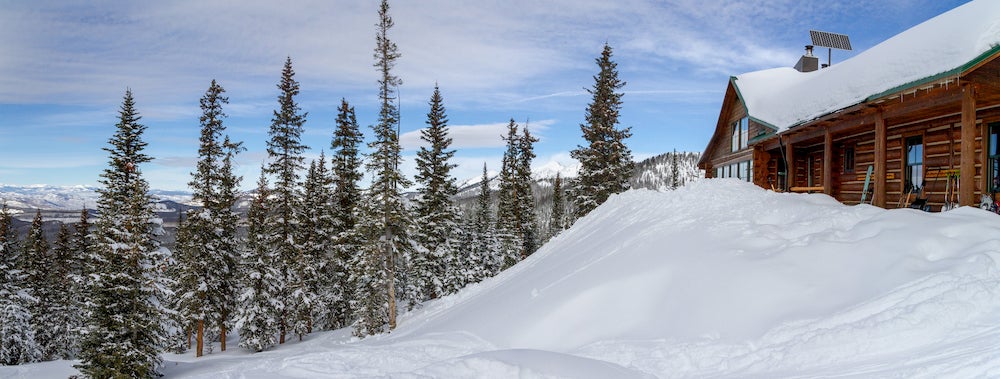
Image from The Dyrt camper Michael B.
Since the huts are owned by different parties, costs for reservations vary, and certain huts require guests to reserve the entire thing (the smaller huts). All huts owned by the 10th Mountain Division Hut Association (Fritz Benedict Hut and Fabi Benedict Hut, McNamara, Margy’s, Harry Gates, Peter Estin, Fowler/Hilliard (subject to additional U.S. Forest Service fees), Jackal (subject to additional U.S. Forest Service fees), Sangree M. Froelicher, 10th Mountain, Uncle Bud’s, Skinner, Betty Bear, and Eiseman) are bookable at $33 per person per night.
The privately owned huts offer the following rates, per the 10th Mountain Division Hut Association pricing page:
- Janet’s Cabin (subject to additional U.S. Forest Service fees): $43 per person
- Francie’s Cabin: $43 per person
- Sisters Cabin: $50 per person
- Section House: $35 per person (closed in summer)
- Ken’s Cabin: $80 for the entire cabin (closed in summer)
- Polar Star Inn: $38 per person (Increasing to $41 per person, effective Winter 2019-2020)
- The Seipel Hut (formerly Carl’s Cabin): $276 for the entire cabin (Increasing to $295 for the entire cabin, effective Winter 2019-2020)
- Continental Divide Cabin: $370 for the entire cabin
- Point Breeze Cabin: $390 for the entire cabin
- Shrine Mountain Inn (subject to additional U.S. Forest Service fees), prices vary as follows, depending on cabin/level:
- Jay’s Cabin: $45 per person
- Chuck’s Cabin-upstairs: $270 for the entire unit
- Chuck’s Cabin-downstairs: $32 per person
- Walter’s Cabin-upstairs: $270 for the entire unit
- Walter’s Cabin-downstairs: $45 per person
- Vance’s Cabin: $30 per person
- Broome Hut: $35 per person
- The Braun Hut System is bookable on a flat rate for the entire hut only at the following rates:
- Tagert, Green Wilson, Markley, Barnard and Goodwin Green: $195 per night
- Lindley: $295 per night
- Opa’s Taylor Hut: $255 per night
- Friends Hut: $25 per person OR $22.50 per person if booking the whole hut (closed in summer)
Planning Your 10th Mountain Division Huts Trip
Given the span and quantity of the 10th Mountain Division Huts across the alpine terrain, there are a vast number of routes that can be taken from hut to hut, and, for the most part, planning your trip should largely be based around what type of hiking or skiing intensity you’re looking for, and the reservations you’re able to snag along the way.
Visit a Hut in the Winter Months (roughly November – March)
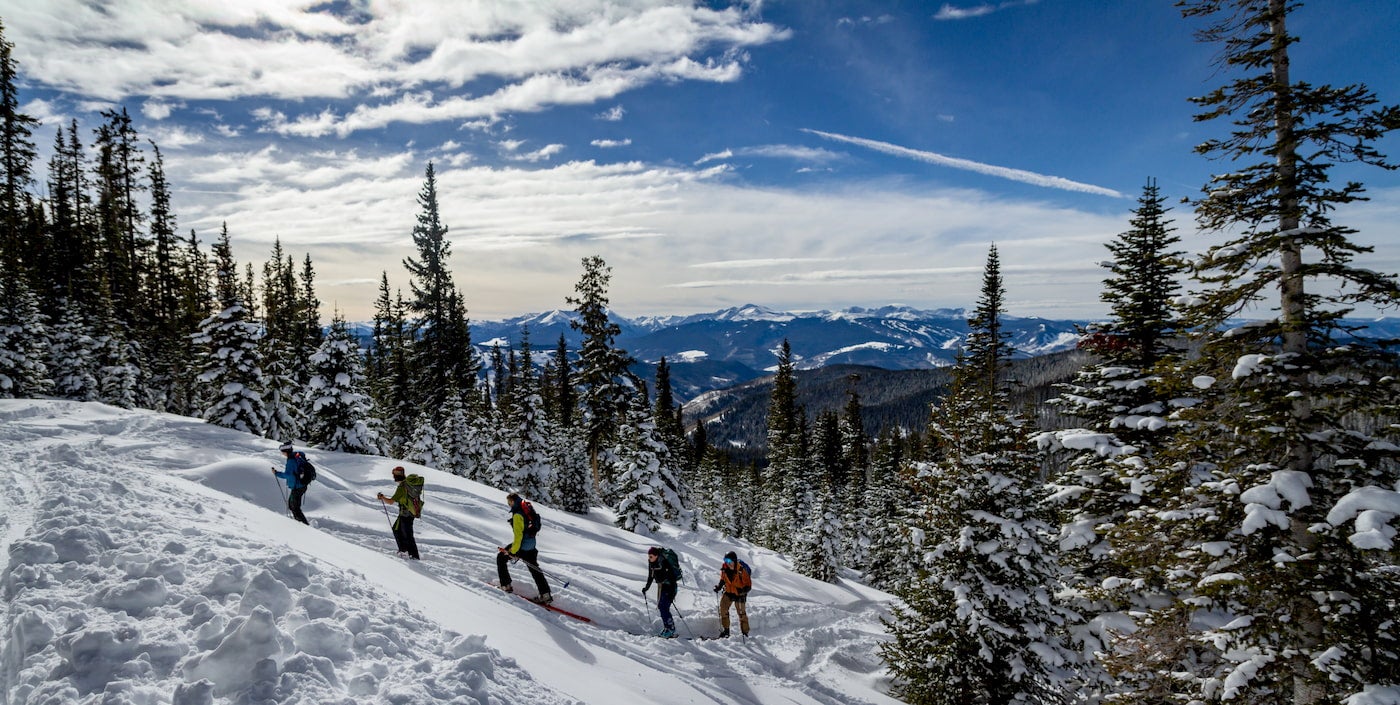
Image from The Dyrt camper Michael B.
As noted above, the majority of the 10th Mountain Division Huts are open year-round, but winter is by far the most popular time to visit, if only for the world-class cross-country skiing available in between the huts.
Route Information
Given the elevation in the Leadville area (9,000 feet + at all times), the backcountry ski routes along the 10th Mountain Division Huts should not be taken lightly. The terrain, altitude, and frequent weather changes all make the skiing in this area for intermediate to advanced skiers only. While the public trails between the huts may be friendlier to those closer to the intermediate side of things, it’s important to be honest about your skill set prior to planning a trip.
It’s recommended that at least one person in every group have the skills necessary for navigating the backcountry, particularly in the wintertime, as well as adequate avalanche safety and first aid skills to be of assistance in case of an emergency. Although most of the 10th Division Mountain Hut trails are well-traveled in the winter months, frequent snowfall and winter storms may make trials difficult to follow. For this reason, a topographical map and experience route-finding is highly recommended.
According to the 10th Mountain Division Hut Association, typical suggested winter routes span between 6-8 miles, with estimated increases of 1800 feet in elevation. Winter routes follow designated cross-country pathways that assume snowfall, and therefore are not the same as summer routes to the huts.
Avalanche Safety
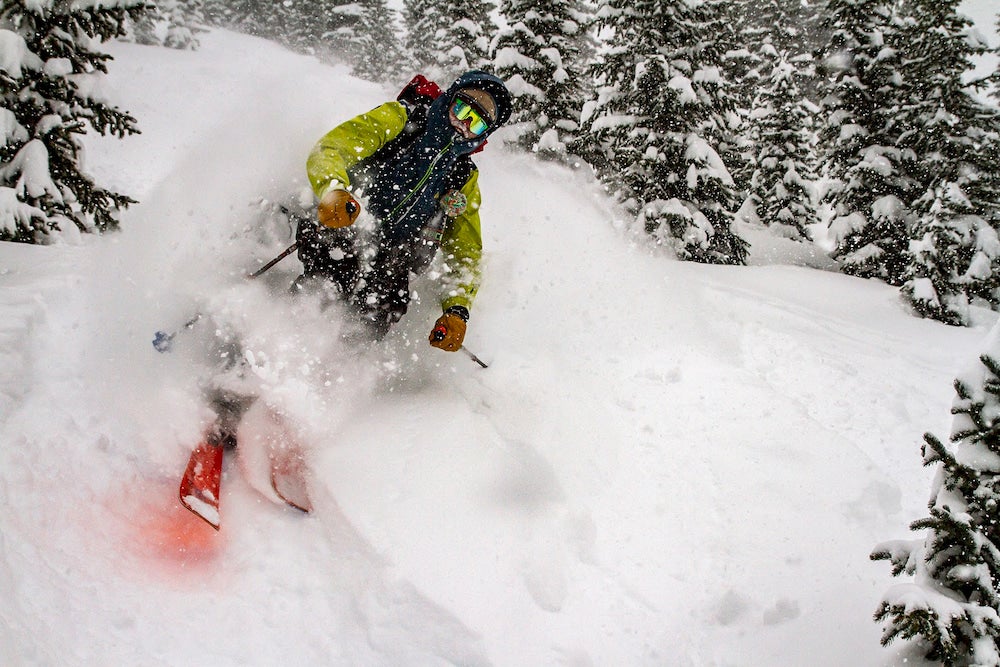
Image from The Dyrt camper Michael B.
While only a few of the 10th Mountain Division Huts are in marked avalanche territory, it’s critical to be aware of the potential hazards to any group making their way along designated trails between the huts. Avalanche safety training is highly recommended for parties planning to travel to the Braun Huts or the Friend’s Hut, as those are the two locations near which avalanche debris has regularly been found. All other trails and huts may be accessed throughout the winter with low risk for avalanche conditions.
The 10th Mountain Division Huts website has a page dedicated to tracking avalanche debris as it pertains to the routes in the Braun Hut System, and is a reliable tool for tracking observed avalanche activity.
Reservations
Due to extremely high demand in the winter months, the 10th Mountain Division Huts are reservable through a lottery system. Reservation lottery submissions can only be made by members of the 10th Mountain Division Hut Association members, although membership can be purchased ($35 for “regular” membership, $100 for “leader” membership, and $1000 for “lifetime” membership) simultaneously when submitting a lottery form. Each member is granted one lottery form per winter. Trips may be booked for multiple people and multiple nights by one member, but must be a part of a single itinerary. Multiple itineraries/ huts may be selected on your lottery form, but must be specified in order of preference, and only one itinerary will be granted, if at all.
The lottery begins on the first day of March for the next winter season, and all lottery forms are typically due in the middle of February. The lottery drawings occur manually, and, if available, trips are automatically booked based on the itineraries and credit card information provided.
Post-lottery bookings may be made for members starting on the first weekday in April. For non-members, bookings may be made online and over the phone starting the first weekday in June. If you fail to make a reservation before the huts fill up, you may add your name to a waitlist for hut cancellations.
Note: Certain privately owned huts may be booked through the 10th Mountain Division Hut Association, but may not be a part of the lottery system. Be sure to check relevant dates and reservation policies for specific huts via the 10th Mountain Division Hut Association hut list.
Visit a Hut in the Summer Months (roughly May – September)
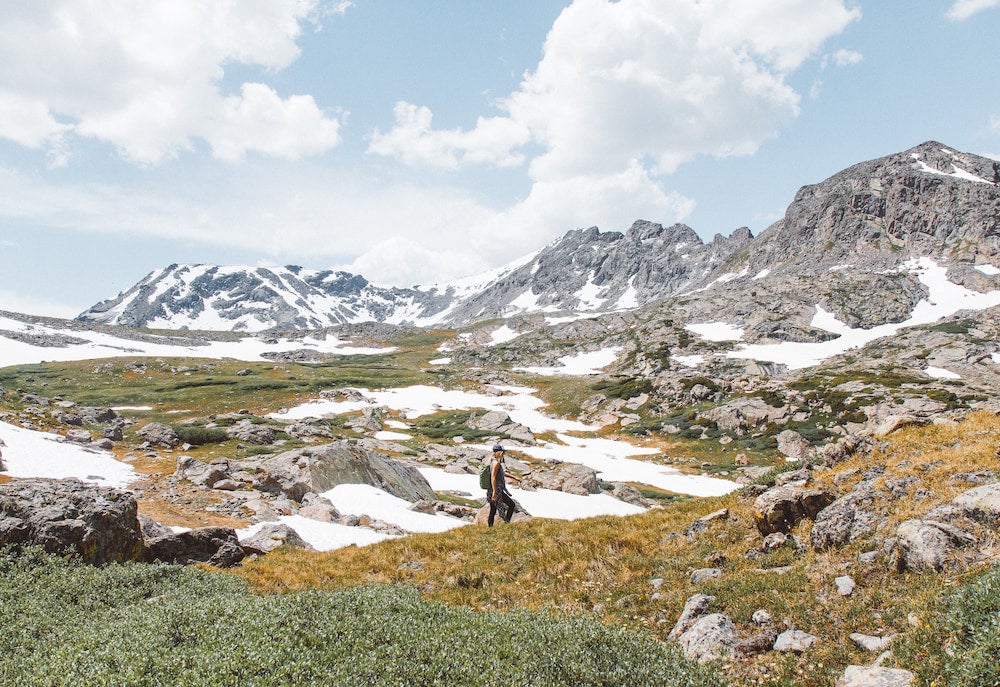
Summer in the Rockies can be one of the most rewarding times of year to explore the alpine wilderness, as wildflower blooms and native wildlife sightings abound. As opposed to the winter months, summer hikes between the 10th Mountain Division Huts can be a warm, inviting look into the best of Colorado’s epic wilderness.
Route Information
All that said, the weather may be different, but the altitude and general strenuousness of the hikes are about the same. Hikers should be aware of the perils of altitude sickness, and all parties should be diligent about maintaining hydration as well as checking for signs of dehydration, altitude sickness, and overall exhaustion. Despite the warm temperatures, weather in the Rocky Mountains can change with extreme speed, and at such high altitude a severe change in weather can be as dangerous as an avalanche. Both heat and rain can be extreme at or above 9,000 feet, so being prepared for all conditions is imperative for hopeful hikers.
The 10th Mountain Division Hut Association recommends that all hikers bring extra food and water along on their planned trips, as thunderstorms and snowmelt can make travel on backcountry roads and trails tenuous and, in some cases, impossible. As with cross-country skiing in this area, it is recommended that only backcountry hikers and backpackers with intermediate to advanced skills make the trek from hut to hut, and that at least one member of each party is equipped with the necessary first-aid and lightning safety experience.
Note: Suggested routes in the summer months follow designated roads and trails, but are not maintained in the same fashion as winter (there may be few markers set, or none), so a topographical map and route-finding skills may be necessary depending on the trails you select.
Reservations
Reservations for trips to the 10th Mountain Division Huts during the summer months are not booked through a lottery system. Reservations may be made online and over the phone starting on the first weekday of October, and does not require that interested parties be members of the 10th Mountain Division Hut Association.
Note: As mentioned above, privately owned huts may have different reservation windows for the summer months. Reservation information for the privately owned huts is available via the 10th Mountain Division Hut Association hut list.
What To Bring
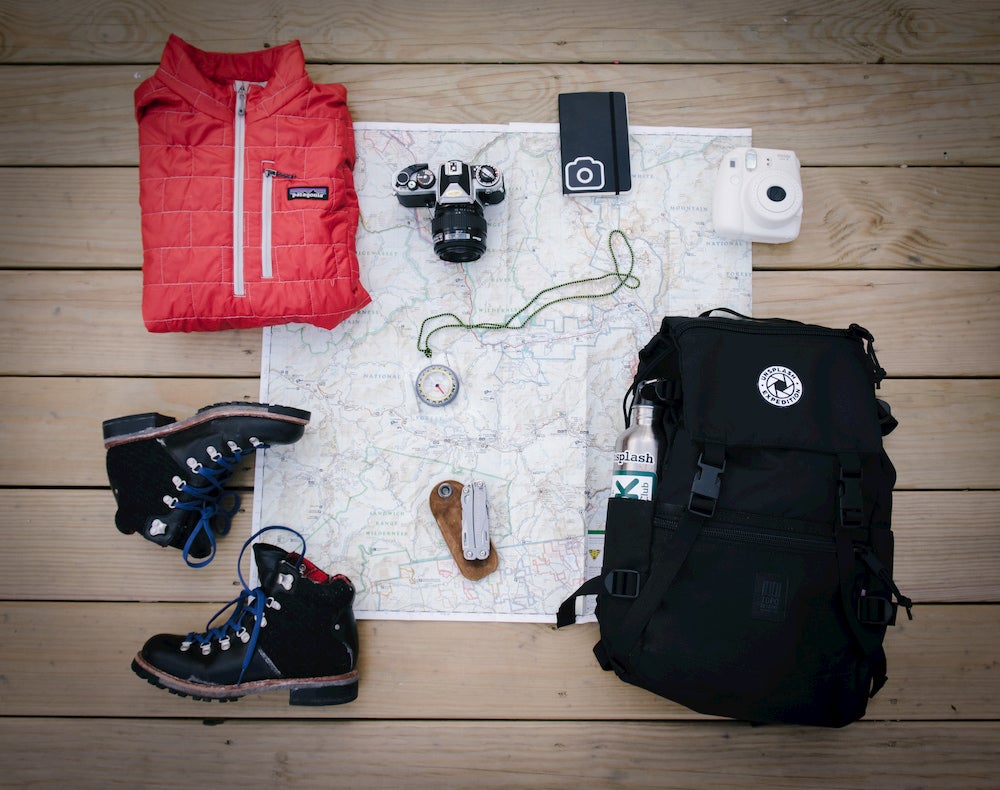
Most huts are equipped with all basic amenities, including water (or a means for melting snow) and cooking appliances. That said, guests should prepare for a stay at the 10th Mountain Division Huts as they would for a car camping trip by bringing the following items:
- Toiletry Items (toothbrush, toothpaste, etc.)
- Sleeping bag
- Pillow case (pillows are provided)
- Food (all huts offer utensils)
- Layers
Guided Trips to the 10th Mountain Division Huts
For groups looking for a guided wilderness experience to the 10th Mountain Division Huts, the 10th Mountain Division Hut Association offers several recommended, permitted guiding partners for both the summer and winter. Guides are available for all activities allowed in the 10th Mountain Division Huts area, and all outfitters listed below are permitted by the U.S. Forest Service.
Winter Guides:
- Aspen Alpine Guides – Aspen (970) 925-6618
- Aspen Expeditions – Aspen (970) 925-7625
- Paragon Guides – Vail (970) 926-5299
- Irwin Guides – Crested Butte (970) 349-5430
- Colorado Backcountry Guide Service – Crested Butte (970) 349-0800
Summer Guides:
- Aspen Alpine Guides
- Aspen, CO (970) 925-6618
- Activities: backpacking, hiking, mountain biking, climbing.
- Indian Summer Outfitters
- Edwards, CO (970) 926-1578;
- Activities: horsepacking.
- Paragon Guides – Vail (970) 926-5299; activities: backpacking, hiking, mountain biking, climbing.
- The World Outdoors – Boulder 800-488-8483; activities: hiking, mountain biking and multisport adventures.
- Timberline Bike Tours – Aspen (970) 274-6076; activities: mountain biking.
More Information on Planning Your Trip
For more information on planning your trip, including rates, availability, and planning support, visit the “Education” section of the 10th Mountain Division Hut Association’s website.
This article was brought to you by OOFOS

Pick up a pair of sport slides from OOFOS today!
Related Campgrounds:
- Twin Lakes Colorado Camping, Leadville Colorado
- Timberline Campground, Park County, CO
- Vail Camping, Vail, CO
- Vail Colorado Camping, Vail, CO
- Clear Creek RV Park, Golden, CO
Popular Articles:
Articles on The Dyrt Magazine may contain links to affiliate websites. The Dyrt receives an affiliate commission for any purchases made by using such links at no additional cost to you the consumer.

